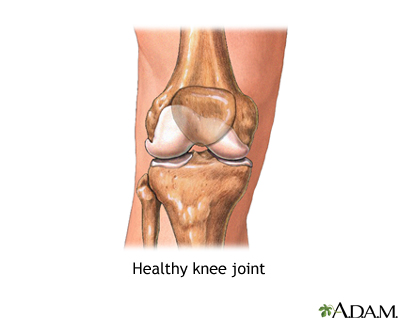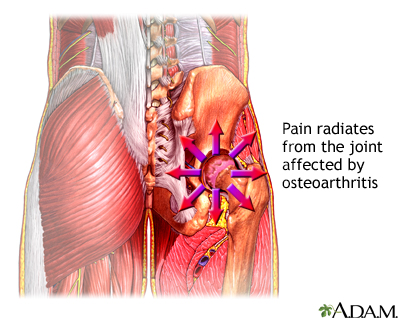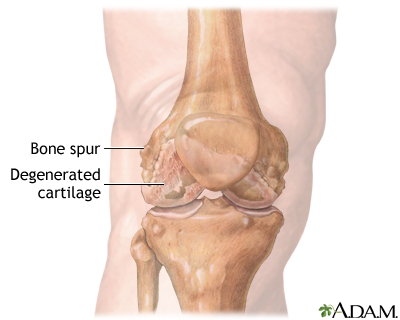| Step 2: Symptoms |
People with osteoarthritis often experience the following symptoms in their joints:
- Aches and pain
- Stiffness and loss of mobility
- Swelling
- Bone growths, knobs, and cysts

NormalOsteorthritis
People often find that it becomes more difficult to climb stairs, open jars, and perform other activities as the disorder progresses.
Pain
Osteoarthritis often involves a deep ache within or near the affected joint. Most people experience joint pain that worsens during the course of the day. Other people, however, report the greatest pain in the morning.
- The pain is caused primarily by joint damage. Joint pain results when bony overgrowths rub together or when small stress fractures are present.
- Secondary injuries may occur if pain limits a joint's normal range of motion.
- The body may respond by protectively "favoring" one joint over another. For example, if the painful joint is a knee or an ankle, the "favored" joint may be overused, causing painful muscle strain.
Other painful sensations, such as rubbing or grating within the joint, may be felt when a person performs specific activities, such as bending, kneeling, or stair climbing.
 |
|
Pain does not come from the cartilage (which contains no nerves), but from the adjacent stretched or irritated tissues.
Sometimes osteoarthritis can cause "referred" pain -- that is, pain that is not experienced directly in the damaged joint, but is felt in other regions instead. For example:
- An arthritic hip joint may cause painful sensations in the buttocks, groin, thigh, or knee.
- Arthritis of the spine can cause pain that radiates to the neck, arms, or legs.
- The pain may worsen after stressful life events, such as the loss of a loved one or separation from a spouse.

Stiffness after inactivity
After periods of inactivity (for example, sleeping or prolonged sitting), a person may experience considerable stiffness in the osteoarthritic joint. Stiffness usually lasts for about 30 minutes or less and is improved by mild activity that "warms up" the joint.
Morning stiffness that lasts more than 1 hour should make one think of rheumatoid arthritis more than osteoarthritis.
Bony enlargement and swelling
Progressive breakdown of cartilage may lead to the formation of osteophytes (enlarged bony growths) or "spurs" on the bone ends. Such growths increase the appearance of swelling and knobbiness as they continue the cycle of irritation and swelling.

Once the synovial membrane (smooth tissue that surrounds the joint) becomes irritated by the erosion of cartilage, it may produce an excessive amount of fluid that can collect within the joint and lead to continual or occasional swelling.
Osteoarthritis usually doesn't cause any prominent inflammation (a protective response in which tissue may become red, warm, and tender) in response to injury. This distinguishes it from rheumatoid arthritis, which is associated with considerable joint inflammation. Occasionally people with osteoarthritis experience mild inflammation, although the exact cause of this response remains unknown.
Reviewed By: Ariel D. Teitel, MD, MBA, Clinical Associate Professor of Medicine, Division of Rheumatology, NYU Langone Medical Center. Review provided by VeriMed Healthcare Network.
